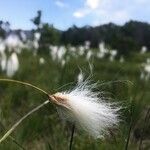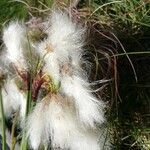Plants colonial from long-creeping rhizomes. Culms 20–60 cm × 0.5–0.8 mm, distally smooth. Leaves: blades trigonous-channeled in cross section, to 30 cm × 1–2 mm; distal leaf blade 1–4 cm × 1–1.5 mm, shorter than its 3.5–5.5 cm sheath. Inflorescences: blade-bearing involucral bracts solitary, similar to distal leaf, blade usually gray or black proximally, 0.6–2 cm. Spikelets (1–)2–5, in subumbels, narrowly ovoid, 7–10 mm in flower, 15–25 mm in fruit; peduncles 5–30 mm, scabrous; scales black or dark gray with black tip, broadly ovate, 3–4 mm, scarious, margins absent or to 0.1 mm wide, 5–9-ribbed, midrib prominent, usually dilated distally, reaching tip, apex obtuse-subacute. Flowers: perianth bristles 10 or more, white, 10–15 mm, smooth; anthers 1–2.5 mm. Achenes narrowly obovoid, 1.5–3 mm.


